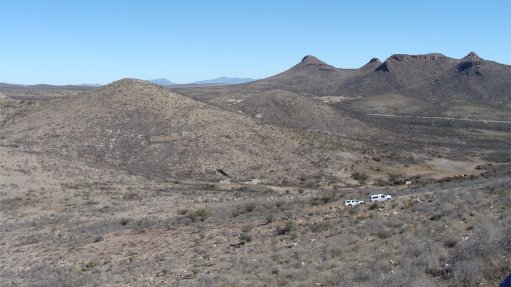
Peñoles, Mexico
Photo by: Morro Bay Resources
TORONTO (miningweekly.com) – Mexico-focused mineral exploration firm Morro Bay Resources this week released results from a drilling campaign at the San Rafael historic mine area, at the multiveined Peñoles project, in Durango state, indicating the presence of multiple mineralised zones.
The Calgary, Alberta-based explorer on Thursday noted that the most recent round of drilling, comprising five holes, focused on a previously untested target in the vicinity of the old San Rafael mine workings, about 2 km east of the Morro Bay discovered gold zone at El Capitan and the high-grade silver vein system at Jesus Maria - all deposits forming part of the Peñoles project.
The drilling intersected multiple stacked mineralised veins that showed good continuity along strike and depth. Drill result intervals included (DDH-14-01) 3.08 m of 1.19 g/t gold and 79.2 g/t silver and 11.9 m of 0.06 g/t gold and 48 g/t silver.
DDH-14-05 returned 8.90 m of 0.63 g/t gold and 101 g/t silver as well as 4.6 m averaging 0.33 g/t gold and 44.9 g/t silver.
This initial work phase was designed to assess the mineralisation associated with the historic San Rafael mine and had successfully identified multiple stacked mineralised zones that warranted more drill testing.
“We are excited by the mineralisation encountered in the San Rafael area. Similar to what has been encountered at Jesus Maria, the San Rafael drilling indicates the presence of multiple mineralised zones. We believe the results at San Rafael are significant and add further to the potential value previously indicated by the El Capitan and Jesus Maria results,” Morro Bay president, director and CEO John Zang said.
The Peñoles project, on which Morro Bay had entered into an option agreement with joint venture (JV) partner Riverside Resources, in October last year, to earn a 51% interest and, eventually up to 65%, is host to multiple mineralised vein systems, fault zone structures, polymetallic skarns and silicified low-temperature, gold-rich volcaniclastics.
In a recent interview with Mining Weekly Online, Zang explained that the mineralisation commonly had high grades of gold and silver with varying amounts of lead and zinc.
About 86 diamond drill holes of more than 10 000 m had been completed at the project.
Initial partner-funded drill programmes focused on the El Capitan zone, which is up to 70 m thick, 700 m long, and extended at least 200 m down dip. More than 30 drill holes had been sunk and the deposit remained open for further expansion potential.
The company was busy drilling on several fronts of the Peñoles property and exploration drilling continued beyond El Capitan with 30 holes and about 3 115 m of drilling completed at the Jesus Maria historic mine area last year.
At least three mineralised zones had been identified at Jesus Maria, including polymetallic replacement bodies, gold/silver veins and breccia bodies. The mineralised horizon in the Jesus Maria zone is at least 1 400 m long, up to 50 m thick and extends at least 200 m down dip. Zang explained that further drilling could extend this zone significantly.
Further, Morro Bay said these most recent drilling results had now extended exploration to include the historic workings at San Rafael.
The Peñoles project, in the Durango silver/gold belt in north-central Mexico, was currently 100% owned by Riverside Resources. The recently completed drill programme was conducted under a commitment by Morro Bay to perform $500 000 of exploration work on the property during the fall.
That commitment had now been satisfied and Morro Bay could complete its option to earn the initial 51% interest in the property by paying $1.25-million in cash to Riverside and C$850 000 (C$750 000 of which may be paid with Morro Bay shares) by December 31.
Zang stressed that gaining control of the 36 000 ha Peñoles project was the company’s most pressing current strategic goal. “Peñoles will someday become a mine,” he stated.
Zang noted that the company was hoping to grow the Peñoles resource base to between 500 000 oz and one-million ounces, at which point it would probably start looking for a JV partner that could take the project to production.
There were about 11 targets on the Peñoles project, including the El Capitan Gold Zone, the Pinchanzo Zone, potential west extensions of El Capitan (referred to as the West Extension), and the previously mined Jesus Maria and San Rafael silver/gold/lead/zinc mines areas. Peñoles also included the El Tubo alteration body, which was yet to be tested in detail for mineralisation.
The TSX-V-listed company believed that the district was highly prospective with active mining operations and excellent infrastructure nearby and had proven to be a cost-effective region where projects could be efficiently developed towards production.
Other operators in the district included Argonaut Gold, Silver Standard, Endeavour Silver, First Majestic Silver and Coeur Mining.